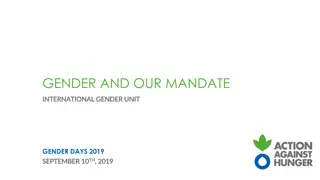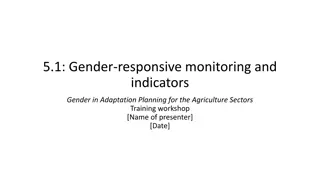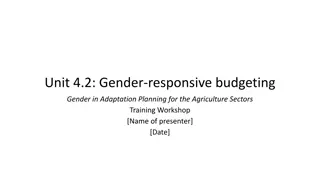Gender Analysis for Adaptation in Agriculture Sectors: Understanding and Implementation
Gender analysis in adaptation planning for agriculture sectors is essential to address gender inequalities, discrimination, and power dynamics. It helps identify how women and men are affected differently by climate impacts, enabling tailored solutions to meet varying needs and constraints. By incorporating gender analysis, adaptation planning can enhance sustainability, governance, and inclusivity.
Download Presentation

Please find below an Image/Link to download the presentation.
The content on the website is provided AS IS for your information and personal use only. It may not be sold, licensed, or shared on other websites without obtaining consent from the author.If you encounter any issues during the download, it is possible that the publisher has removed the file from their server.
You are allowed to download the files provided on this website for personal or commercial use, subject to the condition that they are used lawfully. All files are the property of their respective owners.
The content on the website is provided AS IS for your information and personal use only. It may not be sold, licensed, or shared on other websites without obtaining consent from the author.
E N D
Presentation Transcript
Unit 3.1: Gender analysis for adaptation Gender in Adaptation Planning for the Agriculture Sectors Training Workshop [Name of presenter] [Date]
Learning outcomes Discuss Discuss what gender analysis is and what questions it helps answer. Describe ways that a gender analysis could be carried out to support adaptation planning for the agriculture sectors. Describe Contribute Contribute to a basic gender analysis or perhaps undertake one.
What is gender analysis? Gender analysis is a systematic attempt to identify gender inequalities, their causes and how they are linked to the goals of a policy or plan. Sheds light on how inequitable social, economic and political structures and unequal power relations rise to discrimination, subordination and exclusion. Clarifies how women and men s gender, age, ethnicity, culture, etc. contribute to who they are and how they operate in the world. Identifies men s and women s different knowledge, experience, needs, challenges, roles, responsibilities in relation to adaptation options.
Gender issues to consider in gender analysis for adaptation in agriculture Gender roles define how women and men should act and are linked to the gender division of labour, as well as differences in needs, knowledge and priorities Discrimination of women leads to devaluing of women s work Gender roles and gender-based discrimination give rise to gender gaps in Labour (including time use) Access to and control over productive resources Information (including access to services) Decision-making (household and public sphere) Participation Benefit sharing
Why incorporate gender analysis in adaptation planning? Gender analysis identifies disadvantaged members of a population and the nature of their disadvantage Use it to differentiate the ways distinct groups experience and respond to climate impacts and produce a more complete vulnerability analysis To enrich analysis of climate vulnerabilities Gender analysis identifies skills, knowledge, perspectives of women and men Use it to determine adaptation priorities of different groups so proposed solutions meet varying needs (e.g. labour-saving) and address constraints (e.g. access to land) Use it to harness existing skills and resources in implementing adaptation options To improve sustainability of adaptation options To promote good governance and effective institutional outreach Gender analysis identifies causes of structural inequalities and power dynamics Gender analysis identifies possible impacts of plans/projects on different groups Use it to develop institutional strategies to minimize disadvantages, improve targeting of benefits (financial and other) and increase access to opportunities of adaptation plans
Gender analysis outputs inform adaptation planning in agriculture Recommendations of gender issues to consider Gender equality baseline Gender-responsive theory of change To use as basis for measuring progress on gender equality in implementation of adaptation plan In plan formulation In implementation of adaptation strategies To frame the planning process Gender-responsive results framework Gender Action Plan To guide gender mainstreaming during planning To set gender-related targets
When to conduct gender analysis Information gathering to collect and assess accurate information and inform policy programming design, baseline. Design and implementation to include gender concerns in adaptation activities, and inform identification, selection of beneficiaries, partners. Monitoring and evaluation of adaptation plans, including positive, negative effects on women/men.
What resources needed? Gender analysis framework Resource person(s) Financial, other resources Access to secondary data Access to qualitative data as well as quantitative Expertise to collect primary data if needed
Sources of information for a national-level gender analysis National policies National gender strategies Legislation Government studies/data Research institutes INGOs/NGOs Other World Bank Database OECD Social Institutions and Gender Index (SIGI) UNDP s Human Development Index (HDI) UNDP s Gender Inequality Index (GDI) FAO Gender and Land Rights Database.























